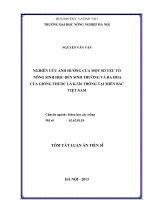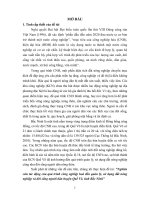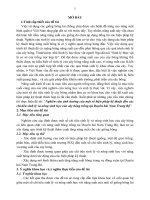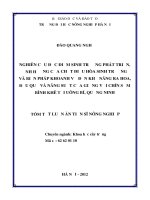Tóm tắt luận án tiếng anh NGHIÊN cứu và PHÁT TRIÊN PHƯƠNG PHÁP đo LIỀU bức xạ GAMMA và NƠTRON DÙNG LIỀU kế MÀNG MỎNG NHUỘM màu
Bạn đang xem bản rút gọn của tài liệu. Xem và tải ngay bản đầy đủ của tài liệu tại đây (507.64 KB, 24 trang )
Introduction
1. The research subject
Dose controlling field associated with sustainable developments of
Nuclear Physics, Nuclear Technology, Radiation Technology and
related fields in the national economy such as industry, agriculture,
health.... This field which has diversified high development and
application aims to exactly control the distribution of irradiated doses
on the irradiated objects. Radiation dosimetry is generally based on
evaluation of absorption energy in which radiation is directly
transmitted to matter by heat increasing, or evaluation of absorption
energy in which absorbed energy is detected by secondary processes
in materials such as ionization, structural change, chemical reaction,
biology, discoloration of materials, etc.
Dyed PVA film dosimeters use organic materials which are the
same tissues, so they are popularly made dosimeters in gamma dose
measurements, particularly in the field of radiation process. Thin film
dosimeters may also be used to measure neutron doses and different
radiations, but they are less noticeable because it is difficult for
estimating the sensitivity in the study dose range due to exactly
known-less dose response. The thesis is expected to detect the dose
response functions and sensitive of the thin film dosimeters used to
measure gamma and neutron doses with the wide dose range with
logical mathematic function and suitable dyes.
With the plan to build and operate a new research reactor to make
radioactive isotopes and to serve the future nuclear power program,
gamma and neutron dose fields shall be important to control the
radiation doses, to ensure the safety for operating people and using
radioactive materials, as well as related technologies. That is the
reasons
why
we
DEVELOPMENT
choose
ON
the
subject
GAMMA
AND
"RESEARCH
AND
NOTRON
DOSE
MEASUREMENT METHODS USE DYED FILM DOSIMETER".
2. The aims of this thesis
1
To manufacture dyed organic film dosimeter which can measure
both gamma and neutron dose, and to determine the sensitivity, dose
range and the dose response function.
3. The object and scope of the thesis
Research and manufacture dyed organic film dosimeter for
controlling gamma high dose in radiation processing and neutron dose
at the channel No.2 of the Dalat nuclear research reactor.
4. Studying problems
- Research, manufacture and application of dyed the films for
measurement gamma and neutron dose;
- To study the factors which affect the working quality of the dyed
film dosimeters for measurement gamma and neutron doses, and to
propose suitable dosimeters.
- Identification of dose response functions for the dyed films.
- Choose the dosimeters with the best particularities
These experiments were carried out at Institute for Nuclear
Science and Technology, Hanoi Irradiation Center, Nuclear Research
Institute, Vietnam Atomic Energy Institute.
5. The structure of the thesis
The thesis is divided into three chapters, including: Chapter I.
Overview of research; Chapter II. Research methods and equipments;
Chapter III. Results and Discussion
6. The scientific significance and the contributions of the thesis
The thesis has successfully studied and manufactured the dyed
PVA film dosimeter which can control gamma radiation dose in wide
dose range with the optimal radiation sensitivity. In addition, the
thesis is the first study to investigate the properties of the PVA thin
films when they are exposed on the thermal neutron source at channel
2 of the Dalat nuclear research reactor. From the research results, the
thesis has published 7 scientific papers.
7. The reality meaning of the thesis
2
The thesis has contributed to the development of a new dosimeter
which is capable of controlling both the gamma dose with a wide dose
range and neutron doses in the research reactor.
Chapter I. Overview of study
1.1 Overview of study situation
1.1.1 The study situation in the world
The studies of the dyed PVA film dosimeter for the gamma dose
control in the world are highly developed and widely applied such as
the radiation processing, medical and also in reactors. However, these
studies were only surveyed effects of films when they were exposed
by gamma irradiation with different dose ranges. The specificity dose
response curve for each study dose range has not been established
correctly. In addition, the study of neutron dose with the dyed PVA
film is less well studied in the world.
1.1.2 The study situation in Vietnam
Chemical dosimeters and solid dosimeters are almost exclusively
used in gamma dose control, or used to determine the environmental
dose. Research and manufacture of dosimeters in neutron dose control
is also an open field.
1.2 Methods of common dose measurement
1.2.1 Dosimeter classification
With difference configurations and components as also working
process, there are the primary dosimeter and the second dosimeter.
With the quality, precision level and usage, there are four types of
dosimeters: Dosimeter system of first level Standard, Dosimeter
system of secondary Standard, Dosimeter system of standard transfer,
Routine dosimeter system
1.2.2 Some criterions for dosimeters selection with different dose
ranges
1.2.2.1 Some criterions for dosimeters selection
With the usage target, they are used to use some criterions for
dosimeters selection such as relative dose measurement or absolute
3
dose measurement, the accuracy or repeatability of the dose
measurements, the total dose or dose rate, measurement while they
were online or offline, dose ranges, type of radiation and radiation
energy, spatial resolution, type of equipment for dose measurement,
price of dosimeter, private density of dosimeter and mechanical
quality.
1.2.2.1 Dose range for dosimeters
The subjects of radiation processing and radiation technology are
used in the high dose ranges from several hundred gray to hundreds of
kilogray.
1.2.3 Unit of dose measurement and determination
a) Absorbed dose: Gray (Gy) unit, which 1Gy = 1J / kg.
b) Absorption dose rate: Gy / s, which 1Gy / s = 1J / s.kg = 1W / kg.
c) Kerma and Kerma rate: The Kerma unit and the Kerma rate are
the same as the unit of dose measure and rate.
d) Energy leakage line: The energy leakage line is the energy which
is lost from the surface of a unit of volume considered and determined
by the expression J / , where J is the density vector of energy line
and is the absorpted material density.
e) Dose equilibrium equation: The dose equilibrium equation is
written as follows:
dE
where
dEk J dEb
dm dm
dm
dEk dEb
J
,
dm
and
dm
is the sum of the initial kinetic energy, the
energy consumed by the braking process and the energy leakage line
of the charged particles.
f) Radiation dose: The unit in the SI system is C / kg. The unit
commonly used is Roentgen R.
Radiation dose rate: The unit in the SI system is C / kg / s. The unit
commonly used is R / h or mR / h.
4
g) Equivalent dose: The equivalent absorbed dose or equivalent dose
of H is the quantity to evaluate the degree of danger of the radiation,
by caculation of the absorbed dose D and the the radiation weighting
factor WR:
H D.WR
h) Radiation chemical yield G and activated molecular
probability: G values are measured by the number of chemical
changes for 100 eV of the absorbed energy of ionizing radiation.
1.2.4 Some dosimeters for high control
1.2.4.1 Calorimetry
Calorimetry is a method of directly measuring the absorption energy
of a substance with radiation. The absorption dose D (Gy) is
determined by the formula:
D
T .C
m
where, T is the temperature rise with unit [K], C the heat capacity of
the calorimeter with unit [JK-1], m is the mass of the calorimeter with
unit [kg].
1.2.4.1 Dose measurement method based on ionization of gases
According to the Bragg-Gray principle, the absorbed dose can be
calculated by the formula:
Dm W.Sm P
Where W is the ionic pair energy in the gas (J / ion), Sm is the ratio of
lost energy for a unit of density of the surveyed material and air, P is
the number of ion pairs generated in a unit of gas volume (pair / kg).
1.2.4.2 Chemical dosimeter
Chemical dosimeters are secondary dosimeters in which absorbed
dose is determined from a chemical change produced on irradiation:
5
where, product yield unit is mol.kg-1, G is in units of active molecules
per 100 eV.
Some typical chemical dosimeters: Gas-phase dosimeter, Liquid
dosimeter, Fricke dosimeter, cerium sulfate dosimeter and solid-State
dosimeter
Summarization of Chapter I
In this chapter, the thesis gives the overviews of the study situation
and the method of measuring gamma and neutron radiation dose using
dyed PVA film. In addition, in this chapter we have listed some of the
commonly dose measurement methods which are used in high-dose
radiation control technology.
Chapter II. Research methods and equipment
2.1 Interaction of radiation with PVA matter
2.1.1 Effects of cross-linking and degradation of polymer
Effects of cross-linking and degradation are not reversible effects,
significantly altering the structure and properties of polymers.
2.1.2 Gas separation effect
In the irradiation process with PVA by the gamma source, the gass
products released are very strong. In this process, the common gases
are H2, CH4, CO2, CO.
2.1.3 Radiation oxidation and after irradiated of polymer
In many cases oxygen has a significant effect on the radiolysis of
polymers and leads to their oxidation. The radiation oxidation rate
depends on the concentration of oxygen in the polymer, the effect of
the dose rate, the temperature effect and the pressure effect.
2.1.4 Destruction of the structure
Structural destruction is divided into two such as group of point
defects and group of size defect. The first group of point defects
consists of holes, atoms apart of nodes, atoms and centers of color.
The group of size defect consist variables, displacements, and empty
spaces.
6
2.1.5 Transformation of the physical properties of the irradiated
polymer
Irradiation on polymer materials often changes the physical
properties of materials such as electrical charge, mechanics, memory
effect, and heat shrinkage.
2.1.6 Radiation protection and radiation sensitivity increase
a) Radiation protection for polymer: Radiation resistance increases if
polymer is added special material which called protective additive.
b) Sensitivity increase with radiation-chemical processes in the
polymer: The polymer is added additives which impulse radiationchemical process and lead to desirable effects.
2.2 The trasmitable process of radiation energy to matter
2.2.1 Linear energy transfer coefficient
The L-LET energy transfer coefficient of the charged particle in the
material is determined by the formula: L
dE
dl
, where dE is the
average loss energy of the charged particle on the dl line.
2.2.2 Energy transfer model
The energy transfer model is a typical function of a dosimeter
or study material in that it depends on the dose rate and role of the
background n0 when it is irradiated. It is determined by the following
formulary:
D
D
k0
k0
n D n s 1 e D ' n 0 e D '
where, n (D) is quantity of activated elements, D is dose, D’ is dose
rate that is proportional to the rate of energy transfer imparted to the
material, the coefficients ns, k0 and n0 are defined as follow:
ns
pC
n
pq
, k0 p q ,
n 0 n 0
where p and q were the probabilities that one sensitive element will be
activated and reactivated per unit of time, respectively.
7
2.2.3 Different formula of the energy transfer model
+ Different formulas of the energy transfer model incluse: Saturated
exponential formula of quantum theory and theory of particle track
structure, Formula of exponential function, Polynomial, Linear
formula, Super-high dose effect.
+ Dose rate effect: Dose rate effect may occur in some dosimeters.
Experiments show that in the same material, it can be caused different
effects with different radiations and energies.
+ Duality of dose-response curve and radiation incident analysis:
Total dose Dsum is determined: Dsum Di D or D Dsum Di ,
where, Di is incident dose. When D 0 the incident dose is small,
D Ds and D 0 the incident dose is large, D DL .
2.3 Analysis of the dosimeters results by spectrophotometer
2.3.1 Analysis of the dosimeters results by spectrophotometer
When light goes through a substance, it will be occurred the
phenomenon that matter molecules absorbed or radiated of energy and
it is determined by the formula:
where, E1 and E0 are the energy levels of the molecule in initial state
and final state respectively, is frequency of electromagnetic
radiation which is absorbed or emitted, h is Planck constant and
h=6.262x10-34 J.s, is wavelength
2.3.2 Lambert-Beer law
I0
.C .d
I
where, is absorbance coefficient, C unit is mol/l, d unit is cm and D
log
is optical density. The equation is only true for monochromatic rays.
2.5.3 Equipment construction
The measuring system consists of the following parts: light source,
monochromatic component, specimen holder, detector and spectral
recorder.
8
Summarization of Chapter II
The main contents presented in Chapter 2 are:
+ The interaction process with radiation has caused a change in the
structure of the polymer and leaded to chemical and physical changes
in this material.
+ The variation of the polymer when it interacted with radiation
through the transpotation of radiation to matter is based on the theory
of linear energy transfer coefficients and the energy transfer model.
+ Overview of the method of reading the dose from the analysis of
optical density on the spectrometer system.
Chapter III. Results and Discussion
3.1 Study dose measurement of gamma radiation using dyed PVA
film dosimeter
3.1.1 Gamma radiation source 60Co
The 60Co radioactive source is made in the form of a power source
and covered with a thin metal layer to remove emition radiation
from the
60
Co source. The activity of the
60
Co source used in the
radiation processing facilities at the study time was 173.30 kCi at a
distance of 45 cm.
3.1.2 Manufacturing the dyed PVA film dosimeter
3.1.2.1 Preparation of materials and chemiclas
To Include: The PVA powder; four different colors such as
Methylene blue, Methyl red, Methyl orange and Crystal violet;
additives such as Sulfate cadmium, Lithium hydroxide monohydrate,
Boric acid, Natri borat decahidrat and Lithium fluoride.
3.1.2.2 Procedures of manufacture
a) Preparation of dye
For convenience in dye mixing with colloidal solutions, dyes are
prepared in the form of 10-3M Methylene blue, 0.4 x 10-3M methyl
red, 10-3M methyl oranges and 10- 3M crystal violet solutions.
b) Preparation of dyed films
9
Prepare films with the following characteristics: The PVA films dyed
with different colors; films with PVA powder masses in the solutions
were 1.47%, 2.94%, 5.88% and 7.35%; films with different additives.
3.1.3 Color change and absorption spectra of the dyed films with
different colors
From Figures 3.4 to 3.7, the amplitude of these absorption bands
decreased gradually with the increase of dose of gamma rays.
Figure 3.4: The absorption spectra of unirradiated and irradiated MB-PVA
films measured at wavelength range 500-750 nm for different doses
Figure 3.5: The absorption spectra of unirradiated and irradiated MO-PVA
films measured at wavelength range 300-600 nm for difference doses
10
Figure 3.6: The absorption spectra of unirradiated and irradiated MR-PVA
films measured at wavelength range 400-600 nm for difference doses
Figure 3.7: The absorption spectra of un-irradiated and irradiated CV-PVA
films measured at wavelength range 540-650 nm for difference doses
3.1.4 Determination of dose-response curve of the dyed PVA film
dosimeter
Figure 3.8 and Table 3.2 depicted the fitted values for the dyed
PVA films with different colors by the energy transfer model:
Figure 3.8: Descriptive dose-response curve of the dyed PVA film
with different colors at specific absorption wavelengths
Table 3.2: The coefficient values are fitted by
the energy transfer model
Phim
no
ns
no/ ns
k
R2
Methyl red
0.8140.011
0.2760.021
2.9500.227
0.0360.005
0.98664
Crystal violet
1.0520.014
0.2140.030
4.9160.689
0.0230.005
0.99426
Methyl orange
0.1590.007
0.0510.006
3.1180.404
0.0240.005
0.96574
Melthylene blue
1.3990.031
0.1900.020
7.3630.788
0.0300.002
0.99435
3.1.5 Evaluation of radiation sensitivity of indicator dyes
To assess the color variability of the dyed PVA films which were
irradiated by the gamma source, we determined the color sensitivity
11
of a dosimeter by the formula: s
n0
ns
, where, n0 and ns are
respectively number of the activated element at D=0 and D=∞. These
results showed that The MB-PVA dyed films were the best
dosimeters.
3.1.6 Study the effect of PVA solution concentration on the dyed
PVA films
The changes in optical density values per unit thickness of the dyed
PVA films are determined by the formula:
A / d ( A0 A) / d
where, A0 and A were values of optical density for the un-irradiated
and irradiated films by the gamma source at 668 nm wavelength,
respectively; d was film thickness. Uncertainty of the film density
value is ± 2%.
The dyed PVA films were the best using when the changes in
optical density values per unit thickness were the largest at 2.94%
PVA (Table 3.2, Figure 3.9 and Figure 3.10).
Table 3.2: The optical density values of un-irradiated and
irradiated films with different PVA concentration
Optical density values
%PVA
d [mm]
un-irradiated
irradiated
1.47
0.01
1.458
1.211
2.94
0.02
1.574
0.741
5.88
0.05
1.698
0.576
7.35
0.06
1.711
0.442
Figure 3.9: The changes in optical density values of the un-irradiation
BMB/PVA films with %PVA differences at the 668 nm wavelength.
12
Figure 3.10: The change A/d values of the BMB/PVA films
with %PVA differences at the 668 nm wavelength
3.1.7 The effective investigation of additives on the optical density
values of the unirradiation and irradiation dyed PVA films
Evaluate the color uniformity and thickness of the films after they
are made by casting. The results show that the sampling method
ensures with the color uniformity of the sample is high (Table 3.3).
Table 3.3: The effective investigation of additives on the optical
density values of the unirradiation and irradiation dyed PVA films.
No
1
2
3
4
5
6
7
8
9
10
TB
Stdev
%
d(mm)
BMB0
1.561
1.585
1.639
1.591
1.534
1.592
1.585
1.529
1.566
1.555
1.574
0.032
2%
0.02
BMB2
1.812
1.725
1.851
1.858
1.791
1.754
1.807
1.780
1.771
1.756
1.791
0.042
2%
0.02
Optical density values
LMB1 LMB2 CMB
1.345
1.119
1.301
1.349
1.122
1.3
1.352
1.178
1.353
1.334
1.102
1.311
1.399
1.077
1.311
1.348
1.12
1.301
1.394
1.096
1.3
1.399
1.101
1.338
1.316
1.129
1.31
1.403
1.124
1.353
1.364
1.115
1.318
0.032
0.022
0.022
2%
2%
2%
0.02
0.02
0.02
NMB
2.026
2.083
2.141
2.009
2.144
2.061
2.141
2.063
2.025
2.062
2.076
0.051
2%
0.02
The results presented in Table 3.3 and Figure 3.11 shows that the
NMB film has the highest optical density value and then the BMB2
film. Thus, the addition of sodium borate decahidrate and boric acid
to the dyed PVA film increased the color of the film without the
additives (BMB0) clearly. In contrast, the addition of sulfite cadmium
and lithium hydroxide monohydrate reduced the film color compared
to that before adding it.
13
Figure 3.11: The average optical density values of the films
before and after gamma irradiation at 668nm absorption peaks
Figure 3.12 describes the change in optical density before and
after gamma irradiation at the specific absorption wavelengths of the
dyed PVA films with different additives.
Figure 3.12: The change in optical density of films at 668 nm
after being exposed by gamma source at 25 kGy.
The results A in Figure 3.9 show that the dyed PVA film with
additive has improved the radiation sensitivity of the film compared to
the PVA film without additive. Films containing the LiOH.H2O
additive reduce the radiation sensitivity of the film. The boric acid
improves the best sensitivity of the film with other additive.
3.1.8 Investigate the effect boric acid mass on quality of the dyed
PVA films
In this study, MB/PVA film with 2.94% PVA was exposed
to gamma source at 25 kGy. Figure 3.13 depicts the optical
density values of MB/PVA films with different boric acid
masses at 668 nm before gamma irradiation and the results
show that when the mass of boric acid increased to 150 mg, the
density values also increased. The optical aspect of the previous
14
film also increased. The optical density of the film decreases
rapidly when the mass of boric acid added to the solution is
greater than 150 mg.
Figure 3.13: Change of optical density on the dyed PVA films with
the different boric acid mass before gamma irradiation
at the 668nm wavelength
Results from measurement and invesgation on the Figure 3.14
shows that the optical density change increases when boric acid mass
increases to 100mg and decreases quickly when the boric acid mass is
greater than 100mg.
Figure 3.14: the change A/d values of the dyed PVA films
with boric acid differences at 668 nm wavelength
3.1.9 Evaluation uncertainty of the dyed PVA film for controlling
gamma dose as regular measurement
Uncertainty of the dyed PVA film is 2.40% with trust 68% or
4,8% with the trust 95%. This uncertainty in allowed limit for the
regular measurement at industrial irradiation equipment is small than
10%.
15
3.2 Study some properties of the dyed PVA films irradiated by
thermal-neutron source at the channel No.2 of the Dalat nuclear
research reactor.
3.2.1 Thermal neutron source at Channel 2, Da Lat nuclear
research reactor
The measured thermal neutron flux at an outer position of the beam
line was determined by neutron activation method using Au thin foils.
Neutron dose rate and dose were determined by the thermal neutron
flux with conversional coefficient from neutron flux to dose following
10CFR-20 (USA) standard. The gamma dose rate which controlled by
TLD dosimeter at irradiation position was 0.0027 Gy/h with
uncertainty <20%.
3.2.2 Manufacturing the dyed PVA film dosimeter
3.2.2.1 Preparation of materials and chemiclas
Including: The PVA powder; Methylene blue dye; additives such
as Sulfate cadmium, Lithium hydroxide monohydrate, Boric acid,
Natri borat decahidrat and Lithium fluoride
3.2.2.2 Procedures of manufacture
Preparation of the dye and the dyed film is similar to section
3.1.2.2.
3.2.3 The effective investigation of additives on the optical density
values of the unirradiation and irradiation dyed PVA films
To investigate the working status of dyed PVA films with
methylene blue containing different additives, the films were exposed
by thermal neutrons on the Da Lat nuclear research reactor for 10 h
and Identify change of optical density alue of the film. The results of
change survey of the optical density of the films after irradiated are
shown in Figure 3.17. The results show that the BMB0 film does not
contain additives that change the optical density before and after
irradiation is the highest.
16
Figure 3.17: The change of the optical density values of the dyed
PVA films at 668 nm after being exposed during 10 hours by thermal
neutron source.
3.2.4 Survey the state of the film after irradiation
The dyed PVA films after being exposed by the thermal neutron
source were stored in a desiccator at laboratory room temperature.
The results of the investigations of the optical density values of the
methylene blue dyed films were illustrated from Figure 3.18 to Figure
3.23:
Figure 3.18: The absorbance variation of the dyed PVA films without
boric acid and irradiation during 10 hours
Figure 3.19: The absorbance variation of the dyed PVA films with
boric acid and irradiation during 10 hours
17
Figure 3.20: The absorbance variation of the dyed PVA films with
LiF and irradiation during 10 hours
Figure 3.21: : The absorbance variation of the dyed PVA films with
Lithium hydroxide monohydrate and irradiation during 10 hours
Figure 3.22: The absorbance variation of the dyed PVA films with
Sulfat cadmium and irradiation during 10 hours
Figure 3.23: The absorbance variation of the dyed PVA films with
Natri borat decahodrat and irradiation during 10 hours
In order to study the absorbance variation of the post-irradiated
films, we fitted data with the exponential growth function:
abs axe bxday c
18
where, day is storage time of the dyed film after irradiated by the
gamma source (day), abs is optical density values of the dyed PVA
films at day.
Summaries results of coefficients with the exponential growth
function of the dyed films irradiated in 10 hours were described in
Table 3.5.
Table 3.5: The coefficients of the exponential growth functions of the
dyed films irradiated in 10 hours and stored in laboratory condition
Sample
BMB0
BMB2
LMB1
LMB2
CMB
NMB
a
-0.336±0.216
-0.298±0.078
-0.307±0.040
-0.260±0.034
-0.372±0.114
-0.185±0.034
b
0.680±0.317
0.604±0.127
0.221±0.042
0.231±0.043
0.239±0.101
0.248±0.062
c
1.560±0.003
1.748±0.002
1.481±0.008
1.334±0.006
1.488±0.020
2.234±0.006
R2
0.9179
0.9778
0.9526
0.9581
0.7908
0.9154
So that, the Methylene blue dyed PVA films with boric acid can use
as a thin-film dosimeter when they are irradiated by the thermalneutron source with higher stability qualities than another additives. It
is shown that the results are to have high precision.
3.2.5 Investigate the effect boric acid mass on quality of irradiated
films by the thermal-neutron source
The results show that when mass of boric acid is increased, the
change in optical density after exposured by neutron source is reduced
and illustrated in Figure 3.19.
Figure 3.24: Change A/d in the optical density of irradiated
films with different boric acid masses at 668 nm wavelength
3.2.6 Response-dose curves
19
In order to determine the response-dose curves of each film, we put
the films in the thermal-neutron source of 1 hour, 2 hours, 4 hours, 8
hours, 10 hours, 12 hours and 24 hours.
Table 3.6: The changes in optical density values of the Methylene
blue dyed PVA films with different boric acid masses
Irradiated time
(hour)
1
2
4
8
10
12
24
The changes in optical density A
BMB0
0.209
0.203
0.234
0.296
0.347
0.356
0.360
BMB1
0.048
0.065
0.131
0.152
0.189
0.251
0.299
BMB2
0.047
0.038
0.118
0.137
0.142
0.142
0.147
BMB3
0.039
0.060
0.081
0.066
0.088
0.134
0.170
Determine the dose characteristic curve from the changes of
optical density of the film by the exponential function of the energy
transfer result and results are shown in Table 3.6 and Figure 3.25.
Figure 3.25: The changes of optical density in the Methylene blue
dyed PVA films with differnet boric acid masses at 668 nm
wavelength
Table 3.7: The coefficients of the response-dose curves of dyed PVA
films with different boric acid masses
Film
BMB0
BMB1
BMB2
BMB3
no
1.540±0.043
1.648±0.015
1.791±0.013
1.849±0.012
k
n0/ns
R2
7.077±2.729
1.515±0.447
4.491±1.248
0.963±0.610
1.248±0.043
1.247±0.045
1.095±0.011
1.123±0.051
0.897
0.970
0.956
0.928
ns
1.234±0.026
1.322±0.046
1.636±0.011
1.646±0.075
20
So that the response curves of the dyed PVA films irradiated by
neutron source were suitable for the energy transfer model with R2
from 0.897 to 0.970.
Summarization of Chapter III
Chapter 3 presented the results of the study on the reduction of
optical density values of the different dyed PVA films such as crystal
violet dye, methyl red, methylene blue and methyl orange. In this
chapter, we determined of dose-response curves of the different dyed
PVA films. From determining the color sensitivity to gamma
radiation, it was shown that the dyed PVA film with methylene blue
was the best radiation sensitivity with the other dyes. For increasing
the radiation sensitivity of the dyed PVA films, we investigated
%PVA and adding boric acid in the films. So that, the dyed PVA
films 2.94% PVA with Boric acide are dosimeters suitably for the
development and application of high dose in radiation processing in
Vietnam.
The Chapter III was investigated the characteristics of dyed PVA
films with Methylene blue when they were exposed on thermal
neutron source channel 2, Da Lat nuclear research reactor. The dyed
PVA films contain different additives to enhance mechanical strength
and color radiation sensitivity of the films. Our studies show that the
additive in dyed PVA films irradiated on a neutron source increases
the cross-linking process in polymers, leading to increase color
centers and reducing the color center destruction in the films. This
process is contrary to the degradation of the dyed PVA films when
they are exposed by the gamma sources. And the process of
increasing the additive mass of in the films will make more color
centesr and reduce the loss of color after irradiation. Use of the energy
transfer model in determining the specific function of the optical
density of the film when they are exponsed by neutron source is
appropriate.
21
CONCLUSION
In this thesis, we have studied and developed a method for measuring
gamma radiation dose on the dyed PVA films and studied some
properties of the dyed PVA films when they were irradiated by the
thermal- neutron source at channel 2 of the Dalat nuclear research
reactor. The main results of the thesis are summarized as follows:
1. Successfully studied about the dyed PVA films used to control
gamma irradiation dose at dose range from 0 to 150 kGy. In these
studies, we evaluated the color sensitivity with radiation of the films
which were dyed by different colors. We investigated role and
influence of difference PVA solution concentrations on the films. In
order to increase the radiation sensitivity of the film, we added more
different boric acid masses in the films. The results showed that the
dyed PVA films with methylence blue had the best color
sensitivity compared to the other dyes with gamma irradiation
ranging from 0 to 150 kGy. To investigate role and influence of
PVA percentage on film and to show that the dyed film with
2.94% PVA content decreased the optical density of the films.
This means that the film with 2.94% PVA has the best
performance compared to the other PVA%. In order to increase
the radiation sensitivity of the films, we study to add the mass of
boric acid into the films. The mass of boric acid has increased
the optical density value of unirradiation films and and the
reduction of the optical density of the film also increases. So the
gamma radiation sensitivity of the film has also improved
significantly.
2. Initially study characteristics of the dyed PVA films when they are
exposed at the channel No.2 of the Dalat nuclear research reactor.
In this section, we investigated the effect of additives on the optical
density value of the PVA film after exposured by neutron source.
Research results show that adding the additives reduces the
destruction of the color centers of films when they are exposed to
neutron source. This indicates that dye PVA films add the additives
that reduce the color sensitivity of the film by neutron radiation.
22
3. Successfully Investigate and use the energy transfer model to
determine the dose-response curves for the dyed PVA film for the
gamma and neutron irradiation.
The results of this study are credible, which has been
credited by prestigious professional journals to show that dyed
PVA films can be used to control high doses of gamma and
neutron irradiation. However, in order to better evaluate the
dyed PVA films during neutron dose control on the channel 2 of
Da Lat nuclear research reactor, we propose to investigate further
the following issues:
1. Classification of the contribution of gamma dose and neutron dose
to the dyed PVA films when exponsed in the nuclear research reactor
through optical density values.
2. Control and reduce the process of changing the optical density of
the dyed PVA films after they are exponsed by neutron source in the
nuclear research reactor.
23
LIST OF PAPERS RELATE WITH THE THESIS
1. Anh Thi Vo, Nghiep Dai Tran, Giap Van Trinh, Diep Bang Tran,
Binh Van Nguyen (2018) Investigation characteristics of polyvinyl
alcohol films dyed Methylene blue as a radiation dosimeter, Journal
of
Radioanalytical
and
Nuclear
Chemistry,
https://doi,org/10,1007/s10967-018-5921-2
2. Anh Thi Vo, Nghiep Dai Tran, Giap Van Trinh, Son Ngoc Pham
(2018) Effect of thermal neutron irradiation at No. 2 channel of Dalat
nuclear research reactor on dyed polyvinyl, Journal of Radioanalytical
and Nuclear Chemistry, />3.Vo Thi Anh, Tran Dai Nghiep, Trinh Van Giap (2018) To
Determine Dose Response Curves of Dyed Polyvinyl Alcohol Films
Irradiated with Gamma-Rays, Open Journal of Safety Science and
Technology, 8:13-19
4. Nguyễn Thành Công,Võ Thị Anh, Trần Đại Nghiệp (2016), Nghiên
cứu sự hấp thụ bức xạ gamma trong phim đổi màu do bức xạ, Tạp chí
khoa học Trường Đại học Vinh, 45 (1A): 13-16
5. Võ Thị Anh, Trịnh Văn Giáp, Trần Đại Nghiệp, Nguyễn Thành
Công (2018) Nghiên cứu sự nhậy màu của phim Poly(vinyl Alcohol)
nhuộm màu bị chiếu xạ gamma, Tạp chí khoa học Trường Đại học
Vinh, 47 (1A): 14-20
6. Võ Thị Anh, Nguyễn Thành Công, Trịnh Văn Giáp, Trần Đại
Nghiệp và Phạm Ngọc Sơn (2018) Nghiên cứu sự nhậy màu của phim
Poly(vinyl Alcohol) nhuộm màu chiếu trên nguồn nơtron, Tạp chí
Khoa học (Trường Đại học Vinh), 46 (4A): 5-10
7. Võ Thị Anh, Trịnh Văn Giáp, Trần Đại Nghiệp (2015) Ảnh hưởng
của các tác nhân hoá học đối với quá trình truyền năng lượng của
bức xạ gamma trong các phim mỏng, Hội nghị khoa học và công nghệ
Hạt nhân toàn quốc lần thứ XI, 6-7/8/2015, Thành phố Đà Nẵng
24









